All brilliants, when looked at sideways (at right-angles to the girdle), show internal reflections, from whose position and size conclusions about the cut can be drawn. This observation was first reported by Dr. KLUPPELBERG in 1940 in the "Neues Jahrbuch fur Mineralogie", in it he drew attention to light and dark areas in brilliants, which, according to their position, correspond to a definite angle γ.
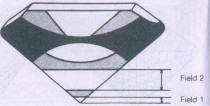 Fig
239 represents, for the sake of simplicity, a four-point as the
preliminary stage in cutting a brilliant, in which two narrow dark,
horizontal bands can be seen very clearly in the pavilion; these are
caused by reflections of the girdle. Their width is dependent on the
thickness of the girdle. For determining the pavilion depth the light
fields visible in the diagram are very important, viz. field 1 (from the
culet up to the lower dark shadow line) and field 2 (between the two
dark shadow lines). These shadow patterns can, moreover, show a reversal
in their degree of brightness, according to the type of lighting -
whether light- or dark field illumination. Fields 1 and 2 are then
darker, whilst the reflection-lines of the girdle appear light. The
height of field 1 is dependent on the angle y and clearly changes with
the size of this angle. The size of field 2, on the other hand, hardly
changes at all in brilliants.
Fig
239 represents, for the sake of simplicity, a four-point as the
preliminary stage in cutting a brilliant, in which two narrow dark,
horizontal bands can be seen very clearly in the pavilion; these are
caused by reflections of the girdle. Their width is dependent on the
thickness of the girdle. For determining the pavilion depth the light
fields visible in the diagram are very important, viz. field 1 (from the
culet up to the lower dark shadow line) and field 2 (between the two
dark shadow lines). These shadow patterns can, moreover, show a reversal
in their degree of brightness, according to the type of lighting -
whether light- or dark field illumination. Fields 1 and 2 are then
darker, whilst the reflection-lines of the girdle appear light. The
height of field 1 is dependent on the angle y and clearly changes with
the size of this angle. The size of field 2, on the other hand, hardly
changes at all in brilliants.
From the ratio of the height of field 1, which changes according to the pavilion depth of the brilliant, to the constant field 2, conclusions can be drawn as to the pavilion depth of a brilliant in this manner:
-
the larger the angle γ -
-
the deeper the pavilion -
-
the greater is the ratio of field 1 to field 2.
Through comparison of the size of field 1 with the height of field 2 the pavilion depth of a brilliant can be approximately estimated. The diagrams in Figs. 240a- 245a shown, in examples of various types of brilliant cut, that field 1 becomes larger in relation to field 2 with the widening' of the angle y and increasing pavilion depth.
Further photographic examples, taken from practice, in Figs. 240-245 show' that in the relevant styles of brilliant the size of field 1 (indicated by H1) can vary between 22.8 % and 43.3 % of the size of field 2. In practical cut-checking of the pavilion depth through sideways reflections it is therefore sufficient to estimate visually whether the size of field 1 amounts to not less than about a quarter, and not more than about half the size of field 1.
Brilliants with a very deep pavilion evoke a large field 1 (Fig 244), whilst extremely flat brilliants often exhibit only one horizontal shadow line, as field 1 lies beyond the culet (Fig 245).
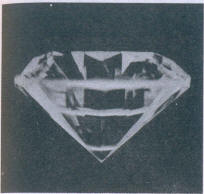 |
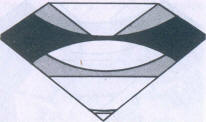 |
| Fig 240 Practical Fine. Cut Type I | Fig 240 a Practical Fine Cut Type I Angle of inclination Y= 38.6° h1 in % of h2=22.8° |
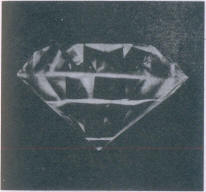 |
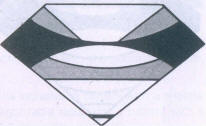 |
| Fig 241 Ideal Brilliant | Fig 241 a Ideal Brilliant Angle of inclination Y = 38.7° h1 in % of h2 = 24.7° |
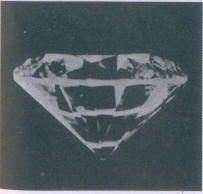 |
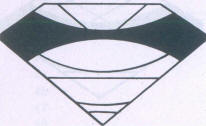 |
| Fig 242 Practical Fine Cut Type II | Fig 242 a Practical Fine Cut Type II
Angle of inclination Y 40.1° h1 in % of h2 = 38.0° |
| Pavilion depth | Table reflection to estimate pavilion depth |